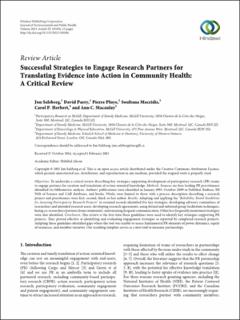| dc.contributor.author | Salsberg, Jon | |
| dc.contributor.author | Parry, David | |
| dc.contributor.author | Pluye, Pierre | |
| dc.contributor.author | Macridis, Soultana | |
| dc.contributor.author | Herbert, Carol P. | |
| dc.contributor.author | Macaulay, Ann C. | |
| dc.date.accessioned | 2021-03-03T13:57:06Z | |
| dc.date.available | 2021-03-03T13:57:06Z | |
| dc.date.issued | 2015 | |
| dc.identifier.citation | Salsberg, J., Parry, D., Pluye, P., Macridis, S., Herbert, C.P. & Macaulay, A.C. (2015). Successful Strategies to Engage Research Partners for Translating Evidence into Action in Community Health: A Critical Review. Journal of Public Health. | en_US |
| dc.identifier.uri | https://hdl.handle.net/11250/2731476 | |
| dc.description.abstract | Objectives. To undertake a critical review describing key strategies supporting development of participatory research (PR) teams to engage partners for creation and translation of action-oriented knowledge. Methods. Sources are four leading PR practitioners identified via bibliometric analysis. Authors’ publications were identified in January 1995–October 2009 in PubMed, Embase, ISI Web of Science and CAB databases, and books. Works were limited to those with a process description describing a research project and practitioners were first, second, third, or last author. Results. Adapting and applying the “Reliability Tested Guidelines for Assessing Participatory Research Projects” to retained records identified five key strategies: developing advisory committees of researchers and intended research users; developing research agreements; using formal and informal group facilitation techniques; hiring co-researchers/partners from community; and ensuring frequent communication. Other less frequently mentioned strategies were also identified. Conclusion. This review is the first time these guidelines were used to identify key strategies supporting PR projects. They proved effective at identifying and evaluating engagement strategies as reported by completed research projects. Adapting these guidelines identified gaps where the tool was unable to assess fundamental PR elements of power dynamics, equity of resources, and member turnover. Our resulting template serves as a new tool to measure partnerships. | en_US |
| dc.publisher | Journal of Environmental and Public Health | en_US |
| dc.rights | Navngivelse 4.0 Internasjonal | * |
| dc.rights.uri | http://creativecommons.org/licenses/by/4.0/deed.no | * |
| dc.subject | research partners | en_US |
| dc.subject | evidence into action | en_US |
| dc.subject | community health | en_US |
| dc.subject | innovasjon | en_US |
| dc.title | Successful Strategies to Engage Research Partners for Translating Evidence into Action in Community Health: A Critical Review | en_US |
| dc.type | Journal article | en_US |
| dc.source.volume | 2015 | en_US |
| dc.source.journal | Journal of Environmental and Public Health | en_US |
| dc.identifier.doi | https://doi.org/10.1155/2015/191856 | |
| dc.source.articlenumber | 191856 | en_US |

